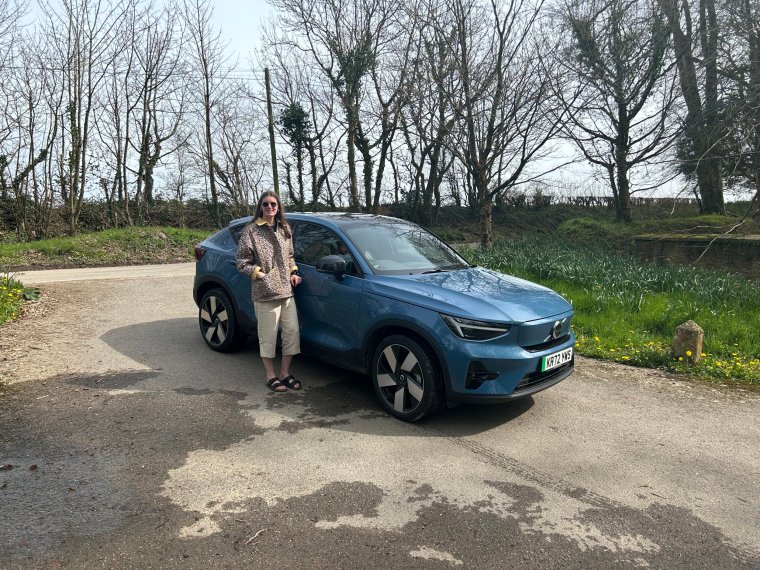The maiden voyage of Guy Stenhouse’s new Jaguar I-Pace in 2019 did not go well. His 145-mile route from Glasgow to Sedbergh in Cumbria was lined with charging points – but most would not charge his car, meaning a trip that should have taken about 2 hours 45 mins took seven hours.
“I stopped at every charging station I could, hooked the car up to the charger only to find it wouldn’t work,” he says.” It meant I was only able to use slow chargers and I could only get about 13 miles of charge each time. I got home at midnight.”
Many electric vehicle (EV) drivers will have heard versions of this story, or even had a similar misfortune themselves – as I did when charging problems elongated a drive between London and Cornwall in an electric car last year. It seems, five years ago, that perhaps Stenhouse was too far ahead of his time, and suffered at the hands of an under-developed charging network that is still evolving.
Stenhouse has since switched to a diesel car. That might sound surprising given that he was an early adopter of a fully electric car, as well as solar panels and a small wind turbine (he even had a hybrid car back in 2016). But he’s not alone in turning his back on EVs. According to the UK-wide independent car supermarket Motorpoint, 56 per cent of EV drivers part-exchanged for an alternative fuel type in 2023, with petrol dominating the choice at 30 per cent.
Mark Carpenter, chief executive of Motorpoint Group, says: “It’s clear that some have found an electric vehicle isn’t right for them. There doesn’t seem to be one reason. Instead, it tends to be a range of factors, for example, moving to a property without a home charger, a new job with a longer commute, or the high price of public chargers.”
There have been other warning signs across the industry, too. In February it was reported that Apple had scrapped its plans to move into the EV market. Tesla’s sales and shares are also dropping, as is the value of second-hand EVs compared with their internal combustion engine (ICE) counterparts. There have also been alarming news reports of incidents when EV brakes failed to work.
Harry Metcalfe, a motoring journalist and co-founder of the car magazine Evo, has also made the swap. After two years leasing an EV and two-and-a-half years with a hybrid electric as the main family car, he’s swapped to a diesel Range Rover Sport (though as a car fanatic, he does have an extensive collection of other cars too). On his popular YouTube channel, Harry’s Garage, he gets into the details of why, and explains he’s “not someone who doesn’t like electric cars”, and he’s another early adopter of green energy, using solar panels and heat pumps. He says that at the moment an EV isn’t suitable for their big drives or for towing a trailer.
He also cites the rising cost of EV insurance, along with depreciation: the value of second-hand EVs has dropped 23 per cent in the past year, according to research from the online marketplace Auto Trader. One reason for this is the Government’s Zero Emission Vehicles mandate, which requires that 28 per cent of all new vehicle sales must be EVs by 2025, increasing incrementally to 100 per cent by 2035. It means manufacturers are pushing new EVs on to the market faster than demand is rising, and that buyers of those can benefit from tax breaks that don’t apply to used cars.
Erin Baker, editorial director of Auto Trader, is an advocate for EVs and runs both an electric and diesel car currently (the latter for long commutes between Kent and Doncaster) and says a barrier to moving into EVs – aside from the initial cost, or deposit if it’s a lease – is the rising cost of insurance. EVs are more expensive to insure due to their higher value and greater repair costs. Some EV drivers are finding themselves uninsurable, or with premiums of up to £5,000, or 72 per cent higher than the previous year, according to Confused.com. “It is costing insurance companies far more, and repairs have gone up because we don’t have enough trained technicians to work on electric cars,” Baker says. “There’s a backlog and the cost for an insurer to provide a courtesy car is higher, so they’ve pushed premiums up.”
Tyres are also an issue, which is the number one problem the AA breakdown service sees in EVs – not running out of charge or fires, contrary to common EV myths. “I hit a pothole in my electric car and the replacement tyre was £160 as opposed to £80 because for an EV the compound is different as it’s got to carry more weight,” says Baker. The AA is seeing an increase in its overall EV workload though, rising from 3.5 per cent over the past 12 months to 4.33 per cent in February 2024, according to an AA spokesperson.
Some of the previously mentioned issues were factors in Stenhouse’s swap to diesel, though his move was gradual, first transitioning to petrol in 2022, then turning to diesel a year later. As well as the journey from hell, Stenhouse says “there were a lot of niggles” with the electric car, which was “always saying ‘traction battery fault’”. It turned out some of the battery cells needed replacing, which “took months for the car to be fixed”.
Luckily it was under warranty, but it was a worrying red flag in such a new car. EV battery manufacturers’ warranties range between eight and 10 years, or 100,000 miles (120,000 for Tesla), whichever comes first. The RAC says batteries need replacing every 10 to 20 years, and estimates the cost for a Tesla Model S to be about £8,000, not including the work to fit it. But battery degradation is even worse news for EV owners living in warmer countries as the heat degrades them faster. Stenhouse also had an issue with the EV’s version of the gearbox, which meant the car was again “off the road for months”.
Ultimately, he says, “the I-Pace was unreliable and I just couldn’t go on long journeys”. Instead, it was finding a four-year-old car with low milage that really cemented moving to diesel. “As people barely drove in 2020, lots of cars have abnormally low mileage. I was able to buy a 2019 car which had done 30,000 miles for 40 per cent of the original price. Now I can drive about 450 miles, fill up where I want and get it repaired by anyone I want.” As it’s a modern diesel, it is also ULEZ compliant (so will not incur a charge in Ultra Low Emission Zones).
After that seven-hour incident, Stenhouse tried to find out the cause of the charging problem. “The charger manufacturer blamed the car, but the car manufacturer blamed the charger. Jaguar said the current was ‘too dirty’ with ‘too many spikes’”. As well as the car and charger not liking each other, the range was also an issue. The car is billed as having a 240-mile range, though Stenhouse says his car “always showed the range as 221 miles”.
In theory, even with 221 miles it should’ve been an easy journey, likely to require just one stop to recharge. But the range of an EV is really only that, a theory. The reason for it? The test conditions for the EU’s Worldwide harmonised Light vehicles Test Procedure (WLTP) are largely unrepresentative of “normal” driving, using an average speed of 29mph in temperatures of 23°C (range performance dramatically drops in cold weather). These temperatures are only seen for a few weeks a year in the UK, at best. And though there are plenty of 30 and 20mph zones, the UK has thousands of miles of main roads and motorways with speed limits of 60 and 70 mph. And what about winter? There is another test at 14°C, but it doesn’t account for the frequent sub-zero temperatures many parts of the UK can experience.

The winter EV range drop was another factor for Metcalfe moving away from EV. In Norway, where low temperatures are a way of life and 89 per cent of cars are electric, drivers have been forced to adapt, avoiding storing their car or battery in a very cold place, using preheating to warm their cars while they are still charging at home, and using less heat to warm the car’s interior to avoid running the battery down.
Baker thinks the future of EVs is in “small, efficient and light EVs”, like her Arbarth 500e. That means there’s not a big range, but she says “the argument in favour of the environment rather tails off” by buying a big three-tonne EV with a bigger range as the hefty weight increases its overall carbon emissions and damage to the roads.
Instead of wanting bigger batteries, Baker says it is attitudes to charging that need to change. The sooner we treat charging EVs in the same way we do our phones, which she describes as the “splash and dash” approach, the better. To encourage more people to EV, “getting the charging infrastructure sorted” is the number one priority. “It’s no use having 22kW or 7kW points at motorway service stations – it’s got to be the really rapid ones,” she adds.
When the lease ends on Baker’s diesel car in a year’s time, she thinks she’ll lease another EV and make use of the salary sacrifice scheme (a benefit allowing an employee’s monthly EV lease cost to be subtracted from their gross salary) which she says is the last Government incentive for EV owners. She’d just need to know “there are enough rapid and ultra rapid charging points that are reliable and that there’s enough of them that are available to use on our commuting route to Doncaster”.
Both sentiments are shared by Mark Carpenter at Motorpoint, who says: “Until we see proper financial incentives for EV buyers from the Government to meet its 2035 target, along with greater investment in the UK’s charging infrastructure, I’m concerned we’ll see more motorists turn their backs on electric vehicles.”
There’s plenty of work to be done before EVs are suitable for all drivers, regardless of geography and driving needs. What would it take for Stenhouse to revert back to an electric car? “If there was a genuine 500-mile range, absolutely, I’d be back”. But for now, his foot is firmly on the brake of the electric car dream.












